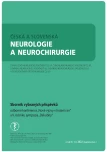Využití podtlakové terapie ran ve vybraném zdravotnickém zařízení
Authors:
L. Krupová 1,2; A. Pokorná 3; D. Jarošová 2
Authors‘ workplace:
Dermatology Department, University Hospital Ostrava
1; Department of Health Sciences, Faculty of Medicine, University of, Ostrava
2; Department of Health Sciences, Masaryk University Brno
3
Published in:
Cesk Slov Neurol N 2022; 85(Supplementum 1): 15-20
doi:
https://doi.org/10.48095/cccsnn2022S15
Overview
Cíl: Cílem studie bylo analyzovat využití podtlakové terapie ran (NPWT) ve vybrané fakultní nemocnici v České republice. Soubor a metodika: Retrospektivní neintervenční studie. Soubor zahrnoval všechny záznamy hospitalizovaných pacientů ošetřených NPWT ve vybraném zdravotnickém zařízení (FN) v období 2015–2017. Data byla extrahovaná z nemocničního informačního systému. Výsledky: Použití podtlakové terapie bylo vykázáno u 276 hospitalizovaných pacientů. Průměrná doba aplikace NPWT byla 19 dní (medián 10), průměrný počet výměn krytí 3,74 dny (medián 2) a interval výměny byl jednou za 2,99 dny (medián 2,33). Podrobná analýza roku 2017 ukázala, že v naprosté většině případů byl výsledek léčby NPWT pozitivní (n = 77; 84,62 %), pouze ve dvou případech nebyl efekt přínosný (2,20 %) a zbytek nebylo možné posoudit jasně (n = 12; 13,19 %). Závěry: NPWT je účinná pro léčba ran mnoha různých etiologií, existují však rozdíly v jejím použití. Vzhledem k tomu, že jsme identifikovali rozdílné přístupy v aplikaci a nedostatek standardizace, předpokládáme, že vzdělávání poskytovatelů zdravotní péče v této oblasti je nezbytným a zásadním aspektem pro podporu vhodného využívání NPWT a také pro sjednocení postupů pro zlepšování kvality péče.
Klíčová slova:
hojení ran – nemocniční informační systém – podtlaková terapie ran– retrospektivní studie
Sources
1. Apelqvist J, Willy C, Fagerdahl AM et al. EWMA document: negative pressure wound therapy. J Wound Care 2017; 26 (Suppl 3): S1–S154. Doi: 10.12968/jowc.2017.26.Sup3.S1.
2. Agarwal P, Kukrele R, Sharma D. Vacuum assisted closure (VAC) /negative pressure wound therapy (NPWT) for difficult wounds: a review. J Clin Orthop Trauma 2019; 10 (5): 845–848. doi: 10.1016/j.jcot.2019.06.015.
3. Joshi CJ, Hsieh JC, Hassan A et al. Application of negative pressure wound therapy on closed incisions. IntechOpen 2019. doi: 10.5772/intechopen.88658
4. Krupová L, Pokorná A. Quality of life in patient with non-healing wounds. Cesk Slov Neurol N 2019; 82/115 (Suppl 1): S40–S43. doi: 10.14735/amcsnn2019S40.
5. Liu S, He C, Cai Y et al. Evaluation of negative-pressure wound therapy for patients with diabetic foot ulcers: systematic review and meta-analysis. Ther Clin Risk Manag 2017; 13: 533–544. doi: 10.2147/TCRM.S131193.
6. Iheozor-Ejiofor Z, Newton K, Dumville JC et al. Negative pressure wound therapy for open traumatic wounds. Cochrane Database Syst Rev 2018; 7 (7): CD012522. doi: 10.1002/14651858.CD012522.pub2.
7. Kirsner R, Dove C, Reyzelman A et al. A prospective, randomized, controlled clinical trial on the efficacy of a single-use negative pressure wound therapy system, compared to traditional negative pressure wound therapy in the treatment of chronic ulcers of the lower extremities. Wound Repair Regen 2019; 27 (5): 519–529. doi: 10.1111/wrr.12727.
8. Webster J, Liu Z, Norman G et al. Negative pressure wound therapy for surgical wounds healing by primary closure. Cochrane Database Syst Rev 2019; 3 (3): CD009261. doi: 10.1002/14651858.CD009261. pub4.
9. Bobkiewicz A, Banasiewicz T, Ledwosiński W et al. Medical terminology associated with Negative Pressure Wound Therapy (NPWT). Under-standing and Misunder- standing in the field of NPWT. Negative Pressure Wound Therapy 2014; 1 (2): 69–73.
10. Everett E, Mathioudakis N. Update on management of diabetic foot ulcers. Ann N Y Acad Sci 2018; 1411 (1): 153–165. doi: 10.1111/nyas.13569.
11. James SM, Sureshkumar S, Elamurugan TP et al. Comparison of vacuum-assisted closure therapy and conventional dressing on wound healing in patients with diabetic foot ulcer: a randomized controlled trial. Niger J Surg 2019; 25 (1): 14–20. doi: 10.4103/njs.NJS_14_18.
12. Panayi AC, Leavitt T, Orgill DP. Evidence based review of negative pressure wound therapy. World J Dermatol 2017; 6 (1): 1–16. doi: 10.5314/wjd.v6.i1.1.
13. Vaidhya N, Panchal A, Anchalia MM. A new cost-effective method of NPWT in diabetic foot wound. Indian J Surg 2015; 77 (Suppl 2): 525–529. doi: 10.1007/s12262-013-0907-3.
14. Lone AM, Zaroo MI, Laway BA et al. Vacuum-assisted closure versus conventional dressings in the management of diabetic foot ulcers: a prospective case-control study. Diabet Foot Ankle 2014; 5: 23345. doi: 10.3402/dfa.v5.23345.
15. Mohseni S, Aalaa M, Atlasi R et al. The effectiveness of negative pressure wound therapy as a novel management of diabetic foot ulcers: an overview of systematic reviews. J Diabetes Metab Disord 2019; 18 (2): 625–641. doi: 10.1007/s40200-019-00447-6.
16. Seidel D, Storck M, Lawall H et al. Negative pressure wound therapy compared with standard moist wound care on diabetic foot ulcers in real-life clinical practice: results of the German DiaFu-RCT. BMJ Open 2020; 10 (3): e026345. doi: 10.1136/bmjopen-2018-026345.
17. Krejčí M, Novotný T, Staffa R et al. The use of negative pressure wound therapy for wound complication management after vascular procedures. Cesk Slov Neurol N 2019; 82/115 (Suppl 1): S29–S32. doi: 10.14735/amcsnn2019S29.
Labels
Paediatric neurology Neurosurgery NeurologyArticle was published in
Czech and Slovak Neurology and Neurosurgery

Most read in this issue
- Sledování prevalence dekubitů – srovnání národních dat s daty konkrétního poskytovatele zdravotních služeb – Fakultní nemocnice Ostrava
- Znalosti sester v oblasti specifické prevence a léčby tlakových poranění pat
- Štandardizácia ošetrovania pacientov s ranami v Rakúsku, Nemecku a na Slovensku
- Pokročilá prax v ošetrovateľstve v oblasti manažmentu rán
